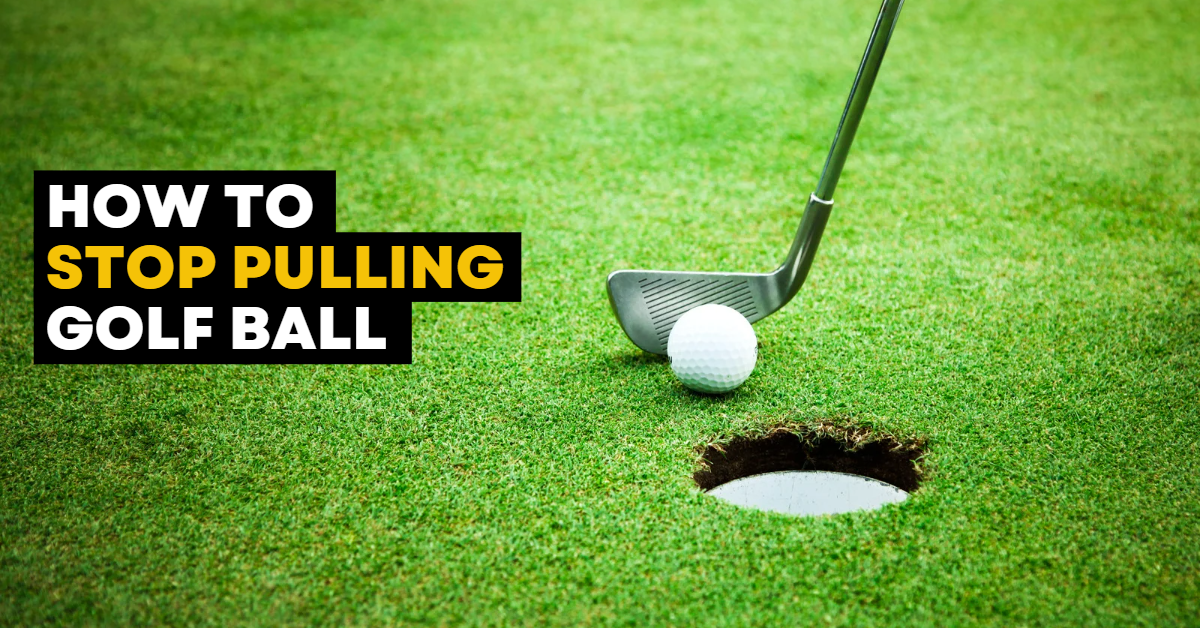How to stop pulling a golf ball – 4 tips
Golf is a beautiful game that challenges players both physically and mentally. However, there’s nothing more frustrating than seeing your golf ball fly off into the trees due to a pull shot.
This common problem can plague even experienced golfers, but fear not – we’re here to help you stop pulling your shots once and for all!
Correct your grip, stance, and swing to stop pulling a golf ball. Ensure a proper grip, balanced stance, and aligned swing path. Practice drills for alignment and swing path. Consistent practice improves accuracy.
Now, we’ll cover how to stop pulling a golf ball. We’ll also explore some effective drills to try out on the course or at home. So grab your clubs, and let’s get started!
How to stop pulling a golf ball – Techniques to prevent ball pulls
To prevent pulling a golf ball, focus on these techniques:
The Grip
It is an essential aspect of your golf swing that can either make or break your shot. A proper grip helps you maintain control over the clubface and produce a consistent strike.
- To start, ensure that you are holding the club in your fingers rather than in the palm of your hand. This will allow for more mobility and wrist action during your swing.
- Next, choose between an interlocking, overlapping, or ten-finger grip based on what feels most comfortable for you. Experiment with each until you find one that works best.
- When gripping the club, be sure to place your hands in a neutral position, with both thumbs pointing down towards the shaft. Avoid having one hand dominate over the other, as this can lead to inconsistency in swings.
- Check that there is enough pressure being applied by both hands on opposite sides of the club. Too much pressure can cause tension, while too little may result in loss of control during swings.
Mastering a proper grip takes practice but can greatly improve consistency and accuracy in shots.
The Stance
The stance is a crucial aspect of golf that it is often overlooked. It sets the foundation for an effective swing and can help you avoid pulling the ball off the course.
- Firstly, make sure your feet are shoulder-width apart with your toes pointing towards your target. This will give you balance and stability during your swing.
- Next, position the ball in line with your front heel to promote a square clubface at impact. Your weight should be evenly distributed on both feet but slightly favoring your lead foot.
- Your knees should be flexed just enough to allow for movement but not too much that it hinders rotation through the swing. Keep your spine straight and tilt forward slightly from the hips.
- It’s important to note that everyone’s stance may vary depending on their height and physical ability. Experiment with different positions until you find what works best for you.
Remember, a proper stance can make or break your shot so take time to ensure it’s correct before making any swings!
The Swing
The Swing is perhaps the most crucial aspect of golf, and it can make or break your game. Pulling a golf ball may be caused by an incorrect swing path or a closed clubface at impact.
- To fix this issue, you need to work on your swing. Start by ensuring that your grip and stance are correctly aligned before swinging. Maintain proper balance throughout the swing to avoid pulling the ball.
- In addition, focus on keeping the clubface square at impact with the ball. Avoid overcompensating for any possible slice by closing off the face too much as this will only lead to more pulls.
- Another tip is to practice hitting shots while focusing on maintaining a straight path towards your target rather than pulling inward towards yourself.
Remember that correcting a pull requires patience and consistent practice. Work on refining your swing through repetition until it becomes second nature.
Drills to Try
To stop pulling a golf ball, it’s crucial to practice drills that can help correct your swing. Here are some drills you can try to improve your game.
- First up is the alignment drill. To do this, place two clubs on the ground, parallel to each other and on either side of the ball. Take note of where your feet are aligned in relation to these clubs before taking a shot. This simple trick helps ensure proper alignment and prevents pulling the ball.
- Another useful drill is the pause-and-check drill. During your backswing, take a brief pause when your club reaches hip level and check if it’s pointing towards the target line.
- Doing this will help you avoid over-rotating or coming too far from inside-out during impact.
- The wall drill is also beneficial for correcting pulls. Stand close to a wall with your back facing it and swing as normal while trying not to hit it. Practicing this drill regularly can help prevent excessive out-to-in swings that cause pulls.
Incorporating these simple yet effective drills into your training routine can make all the difference in improving accuracy and preventing pulls on the course!
3 Set-Up Ideas To Learn How To Stop Pulling The Golf Ball
To learn how to stop pulling the golf ball, consider these three set-up ideas:
- Where Are You Aiming?
Ensure you are aiming properly at your target. Sometimes, pulling the ball occurs due to misalignment. Take a moment to align yourself correctly with your target before swinging.
- Your Grip Might Be Too Strong:
Evaluate your grip on the club. If your grip is too strong, meaning your hands are turned too much to the right (for a right-handed golfer), it can contribute to pulling the ball. Adjust your grip to a neutral position to promote a more accurate shot.
- Poor Ball Position:
Check the position of the ball in your stance. If it’s too far back (closer to your trailing foot), it can cause a pulling shot. Try positioning the ball more toward the center of your stance for better control and accuracy.
By addressing these set-up factors, you can work towards eliminating the issue of pulling the golf ball and improve your overall shot consistency.
3 Swing Tips To Learn How To Stop Pulling The Golf Ball
If you’re struggling with consistently pulling the golf ball to the left (for right-handed golfers), there are several swing tips that can help you correct this issue. Here are three tips to consider:
- Low and Slow:
One common cause of pulling the golf ball is an overly fast and steep swing. To counter this, focus on maintaining a low and slow takeaway.
Start your backswing by keeping the clubhead low to the ground, allowing your arms and body to rotate smoothly. This helps promote a more shallow and controlled swing path, reducing the chances of pulling the ball.
- Drop the Club from the Top:
Pulling the ball can also result from an over-the-top swing, where the club comes down steeply and from outside the target line. To correct this, focus on dropping the club from the top of your swing on a more inside path.
This can be achieved by initiating the downswing with your lower body and hips, allowing your arms to follow naturally. By doing so, you’ll create a more neutral swing path that reduces the tendency to pull the ball.
- Investigate Your Divots:
Examining the divots you create after hitting the ball can provide valuable insights into the cause of your pulls. If your divots consistently point left of the target line, it indicates an inside-to-out swing path, which can lead to pulls.
Conversely, divots pointing right of the target line suggest an outside-to-in swing path, which can cause slices. By paying attention to your divots, you can make adjustments to your swing to promote a more square impact position and eliminate the pull.
It’s important to note that these tips serve as general guidance, and every golfer’s swing is unique. Working with a qualified golf instructor can provide personalized feedback and help identify specific areas of improvement in your swing.
Practice and patience are key, so be sure to dedicate time to implementing these tips on the driving range and gradually incorporate them into your game on the golf course.
Conclusion
Mastering the art of golf can be challenging, but practicing consistently and using the right techniques can help you improve your skills.
Here, we’ve discussed how to stop pulling a golf ball by focusing on your grip, stance, and swing and trying drills that target specific problems.
Remember that no technique is foolproof, so it’s essential to keep practicing and experimenting with different approaches until you find what works best for you. Don’t forget to stay patient and focused during your practice sessions.
Trust in yourself and believe that you have what it takes to become an excellent golfer. With dedication and hard work, anyone can master this beautiful sport!
FAQs:
How do you fix a pulling golf ball?
Take some time to practice focusing on the target and body position. Make sure your club is facing the right direction when you make contact with the ball. When done correctly, this should stop the ball from pulling too much to one side. You can also try shifting your weight and hand position on the club for a more consistent shot.
How do I stop pulling my golf ball to the left?
This may include analyzing your stance, grip, take-away, backswing and follow through. Also, focus on the fundamentals of the grip and posture during practice sessions. Make sure to keep your head down throughout the entire swing and ensure that you are not standing too close or too far from the ball at set up.
How do I stop pulling my irons?
To stop pulling your irons:
- Check alignment
- Strengthen grip
- Correct swing path
- Maintain balance and tempo.
How do you fix a pull draw?
To fix a pull draw:
- Check alignment.
- Adjust grip.
- Swing from inside.
- Maintain balance and tempo.
Why am I hitting a pull hook with my driver?
Causes of a pull hook with the driver:
- Closed clubface.
- Inside-to-out swing path.
- Strong grip or active hands.
- Poor weight transfer/balance.







11 Comments